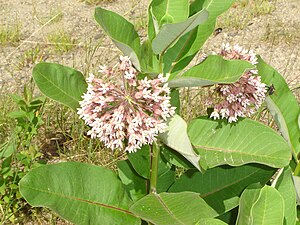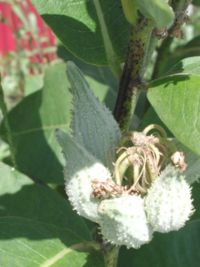Difference between revisions of "AY Honors/Edible Wild Plants/Answer Key"
m (Reverted edit of 205.243.120.126, changed back to last version by Lcarsbot) |
|||
| Line 1: | Line 1: | ||
{{honor_header|2|1970|Nature<br>General Conference<br>2001 Edition}} | {{honor_header|2|1970|Nature<br>General Conference<br>2001 Edition}} | ||
| − | ==1. Photograph | + | ==1. Photograph, collect pictures of or sketch fifteen edible wild plants. Identify each plant in the wild. == |
Several wild edible plants are presented here in alphabetic order. I have included the plants with which I am most familiar, meaning that most of them are available in the Eastern United States. To make this section more universal, please add plants from your own area. This should be done by creating a separate page for the plant and including it thusly: | Several wild edible plants are presented here in alphabetic order. I have included the plants with which I am most familiar, meaning that most of them are available in the Eastern United States. To make this section more universal, please add plants from your own area. This should be done by creating a separate page for the plant and including it thusly: | ||
Revision as of 17:10, 20 September 2007
1. Photograph, collect pictures of or sketch fifteen edible wild plants. Identify each plant in the wild.
Several wild edible plants are presented here in alphabetic order. I have included the plants with which I am most familiar, meaning that most of them are available in the Eastern United States. To make this section more universal, please add plants from your own area. This should be done by creating a separate page for the plant and including it thusly:
{{:Adventist Youth Honors Answer Book/Edible Wild Plants/New Plant}}
Save the page, and then click on the red link you just made to create the new page (or let someone else do that - just knowing which plant to include is a great help). If you choose to add content to the new page, please use the EWP template to maintain uniformity. See the discussion page of the EWP template for its usage, or look at an existing page that uses it (which would be all of the ones below).
Adventist Youth Honors Answer Book/Edible Wild Plants/Bladder Campion
Adventist Youth Honors Answer Book/Edible Wild Plants/Cattail
Adventist Youth Honors Answer Book/Edible Wild Plants/Chicory
Adventist Youth Honors Answer Book/Edible Wild Plants/Clover
Adventist Youth Honors Answer Book/Edible Wild Plants/Dandelion
Adventist Youth Honors Answer Book/Edible Wild Plants/Day Lily
Adventist Youth Honors Answer Book/Edible Wild Plants/Goldenrod
Adventist Youth Honors Answer Book/Edible Wild Plants/Greenbriar
Adventist Youth Honors Answer Book/Edible Wild Plants/Milkweed
Adventist Youth Honors Answer Book/Edible Wild Plants/Pickerelweed
Adventist Youth Honors Answer Book/Edible Wild Plants/Plantain
Adventist Youth Honors Answer Book/Edible Wild Plants/Sheep Sorrel
Adventist Youth Honors Answer Book/Edible Wild Plants/Strawberry
Adventist Youth Honors Answer Book/Edible Wild Plants/Wild Carrot
Adventist Youth Honors Answer Book/Edible Wild Plants/Wild Garlic
Adventist Youth Honors Answer Book/Edible Wild Plants/Wild Grape
Adventist Youth Honors Answer Book/Edible Wild Plants/Wild Onion
Adventist Youth Honors Answer Book/Edible Wild Plants/Wintergreen
Adventist Youth Honors Answer Book/Edible Wild Plants/Wood Sorrel
2. Identify in the wild five trees and five shrubs which are edible.
Trees
Adventist Youth Honors Answer Book/Edible Wild Plants/Acorn
Adventist Youth Honors Answer Book/Edible Wild Plants/Beech Nuts
Adventist Youth Honors Answer Book/Edible Wild Plants/Cherry
Adventist Youth Honors Answer Book/Edible Wild Plants/Hickory Nuts
Adventist Youth Honors Answer Book/Edible Wild Plants/Maple Syrup
Adventist Youth Honors Answer Book/Edible Wild Plants/Persimmon
Adventist Youth Honors Answer Book/Edible Wild Plants/Pine Nuts
Adventist Youth Honors Answer Book/Edible Wild Plants/Pine Needles
Adventist Youth Honors Answer Book/Edible Wild Plants/Sassafras
Adventist Youth Honors Answer Book/Edible Wild Plants/Sumac
Shrubs
Adventist Youth Honors Answer Book/Edible Wild Plants/Autumn Olive
Adventist Youth Honors Answer Book/Edible Wild Plants/Blackberry
Adventist Youth Honors Answer Book/Edible Wild Plants/Blueberry
Adventist Youth Honors Answer Book/Edible Wild Plants/Cranberry
Adventist Youth Honors Answer Book/Edible Wild Plants/Gooseberry
Adventist Youth Honors Answer Book/Edible Wild Plants/Rose
Adventist Youth Honors Answer Book/Edible Wild Plants/Serviceberry
Adventist Youth Honors Answer Book/Edible Wild Plants/Spicebush
3. Identify, prepare, and eat three kinds of wild berries or fruits, three kinds of beverages, three salad plants, three potherbs (greens), and two tubers or roots.
Fruits and Berries
See above on Blackberry, Blueberry, Cherry, Grape, Persimmon, Strawberry, and Wintergreen.
Beverages
See above on Chicory, Dandelion, Goldenrod, Sassafras, Sheep Sorrel, Sumac, Wintergreen, and Wood Sorrel
Salad Plants
See above on Dandelion, Greenbriar, Plantain, Sheep Sorrel, Wood Sorrel
Greens
See above on Dandelion, Plantain, Milkweed
Tubers or Roots
See above on Carrot, Cattail, Garlic, Onion, and Sassafras
4. Demonstrate the preparation of wild foods in each of the following ways:
a. Boiling
Any of the greens are prepared by boiling.
b. Frying
Clover Pancakes
Collect about one gallon of clover flowers and let them dry for two weeks (or dry them in the oven at 250°F for 30 minutes and then let them sit overnight). Once they are dry, grind them to powder using a mortar and pestle to make a fine flour. This will produce about a cup of flour. Mix this half-and-half with wheat flour and make pancakes.
Fritters
- Dandelion flower heads can be dipped in batter and fried to make fritters.
- Milkweed flowers can also be battered and fried, but they must be dipped in boiling water for one minute first.
- Black Locust flowers also make excellent fritters.
c. Roasting
See above for acorns, chicory, pickerel weed, and pine nuts.
d. Baking
Pie
Delicious pies can be made from blackberries or blueberries. Wild cherries are not really large enough for this, but if you find them in quantity, you might make a go of it.
Bread
Try baking bread by mixing wheat flour with any of the various "wild" flours made from clover, acorn, cattail pollen, or cattail roots.
5. Demonstrate how to prepare four parts of the common milkweed or day lily for food.
Milkweed
The parts of a milkweed plant that are edible are the leaves, stems, shoots, flowers, and pods. The pods must be collected while they are young, and the flowers are not in season for very long. All are prepared essentially the same way, which is by boiling them in several changes of water. Boiling eliminates the bitter, milky sap from which the milkweed derives its name.
Prepare the milkweed by filling a large pot with water and bringing it to a boil. When the water is close to boiling, fill a small pot with water and bring it to a boil as well. When both pots are boiling, place the milkweed in the smaller of the two and let it boil for about a minute. Pour the water off and then refill the small pot from the large pot. You may wish to use a ladle to dip the boiling water from the large pot into the smaller one. You do not want to cover the milkweed with cold water as this will set the bitterness. Boil the second batch of water for a minute also, drain it off, and refill. Subsequent changes of water should remain in the pot for a few minutes. After no fewer than six changes of water, the milkweed should be ready to eat. Add a little butter if desired and prepare to treat your taste buds.
Day Lily
See requirement #1 for information on preparing the shoots, buds, flowers, and tubers.
6. Explain how to identify three "odd-shaped" edible fungi and how to identify the deadly mushroom amanitas.
Sulphur Shelf
Description: Sulphur shelf (Laetiporus sulphureus) is also known as the chicken of the woods, the chicken mushroom, and the chicken fungus. It is, as one might expect, an edible mushroom with a taste quite similar to lemony chicken. Individual "shelves" range from 2-10 inches across. These shelves are made up of many tiny tubular filaments (hyphae). The mushroom grows in large brackets - some have been found that weigh over 100 pounds (45 kg). It is most commonly found on wounds of trees, mostly oak, though it is also frequently found on yew, cherry wood, sweet chestnut, and willow. Though it does grow off of a living tree, sulphur shelf is not a parasite, though it may cause decay. Young mushrooms are characterized by a moist, rubbery, sulphur-yellow body with bright orange tips. Older mushrooms become pale and brittle, pungent, and are often dotted with termite holes.
Where found: Throughout most of the world
Availability: Late Summer to Fall
Use: Slice thinly and add to stews or simmer for 30 minutes.
WARNING: About half of the population has an allergic reaction to this type of mushroom, with cases being more pronounced in older mushrooms. Due to all of these factors, the mushroom should generally only be eaten when young, and one should always only try a small amount the first time.
Morel Mushrooms
Description: Morel mushrooms have a distinctive, sponge-like cap. The cap is heavily and deeply pitted.
Where found: Moist woods throughout.
Availability: Spring (usually in May)
Use: Use as a cooked vegetable or sauté in butter.
WARNING: When gathering morels, care must be taken to distinguish them from the poisonous false morel (Gyromitra esculenta and others). However, morels are fairly distinctive in appearance. Eating False Morels in quantity can be fatal.
Adventist Youth Honors Answer Book/Edible Wild Plants/Puffball Mushrooms
Adventist Youth Honors Answer Book/Nature/Poisonous plants/Amanitas
7. What root plant can be dried and ground into meal?
- Cattail
- Greenbriars
- Kudzu
8. Know at least 8 families embracing the poisonous or doubtful plants.
- Buckthorn family (Rhamnaceae) - buckthorns
- Buttercup family (Ranunculaceae) - buttercups, larkspur, baneberry
- Carrot/parsley family (Apiaceae) - hemlock, fool's parsley
- Cherry family (Rosaceae) - cherry (leaves)
- Daisy family (Asteraceae/Compositae) - white snake root
- Dogbane/milkweed family (Apocynaceae) - dogbane, butterfly weed
- Legume family (Fabaceae) - Goat's rue, indigo, locust (seed pods), Lupine, Rattlebox
- Horsechestnut family (Hippocastanaceae) - horse chestnut
- Iris family (Iridaceae) - all are poisonous
- Lily family (Liliaceae)(other than Day lily) - False Hellebore, Fly Poison, Star of Bethlehem
- Crowfoot family (Ranunculaceae) - monkshood
- Mushrooms - many
- Nightshade family (Solanaceae) - nightshade, tomato (leaves), potato (leaves)
- Poison Sumac/Oak/Ivy family (Rhus/Toxicodendron/Anacardiaceae) - poison ivy, poison oak, and poison sumac
- Soapwort family (Caryophyllaceae) - soapwort
- Grape family (Vitaceae) - Virginia creeper
- Yew family (Taxaceae) - yew
9. What is the cardinal edibility rule?
Never eat any wild plant unless you have positively identified it and know that it is edible.
References
- A Field Guide to Edible Wild Plants, A Peterson Field Guide by Lee Allen Peterson
- Dining on the Wilds, by Miriam Darnall-Kramer, and John Goude




